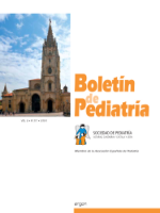Trastornos congénitos de la glicosilación de las proteínas: patogenia y aspectos clínicos
N. Higuera , S. Vázquez , R. Palencia
Bol. Pediatr. 2011; 51 (217): 181 - 187
Objetivo. Este trabajo se propone actualizar los conocimientos a cerca de los trastornos congénitos de la glicosilación de las proteínas (CDG), en los aspectos referentes a la patogenia y manifestaciones clínicas. Desarrollo. Realizamos una revisión de la literatura considerandola evolución histórica de estas enfermedades, las bases bioquímicas y genéticas que permiten una clasificación, así como las manifestaciones clínicas; se hace especial hincapié en la descripción de la variante CDG Ia, la forma más frecuente, de la que se describen las tres etapas evolutivas: infantil multisistémica, infantil tardía y del adulto; de forma más breve se comentan las características de las variantes CDG Ib y CDG Ic. Conclusiones. Los CDG constituyen una patología emergente que dada su heterogeneidad clínica debe sospecharse en todo paciente con un cuadro neurológico inexplicable, en particular si junto a retraso psicomotor, hipotonía y epilepsia, asocia alteraciones hepáticas o de la coagulación, así como en casos de hipoplasia cerebelosa u olivo pontocerebelosa de aparición en el período neonatal.
Congenital disorders of glycosylation of proteins. Pathogeny and clinical features
Objective. This work aims to provide an up-date on the knowledge regarding congenital disorders of glycosylation (CDG) of proteins in aspects on pathogeny and clinical manifestations.
Development. We performed a review of the literature, considering the historical course of these diseases, biochemical and genetic bases that permit their classification and the clinical manifestations. Special emphasis is placed on the description of the CDG Ia variant, the most frequent form, describing the three evolutive states: infantile multisystem late-infantile and adult. Briefly, we comment on the
characteristics of the CDG Ib and CDG Ic variants.
Conclusions. CDG is an emerging disease that, given its clinical heterogeneity, should be suspected in all patients with an unexplainable neurological picture, especially if it is accompanied by psychomotor retardation, hypotony and epilepsy, if it associates hepatic alterations of coagulation disorders and in cases of cerebellar hypoplasia or pontocerebellar and olive hypoplasia appearing in the neonatal period.
Artículo completo (PDF) (99 kb.)
- Endocrino-Metabolismo
